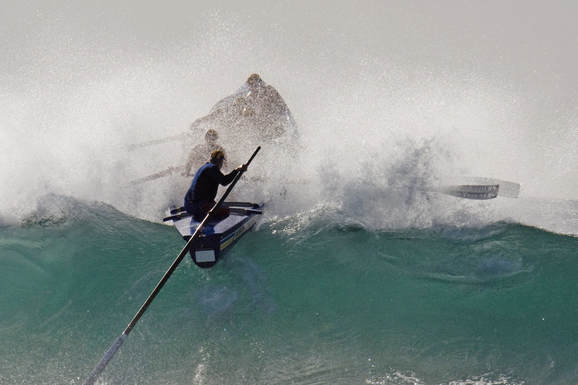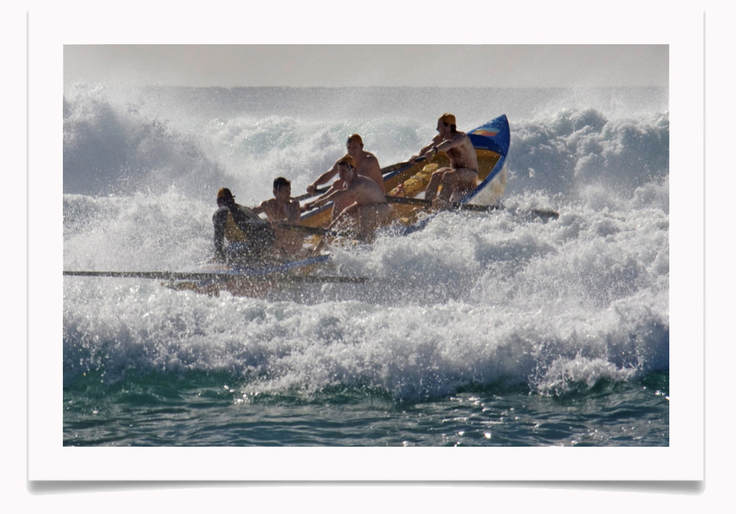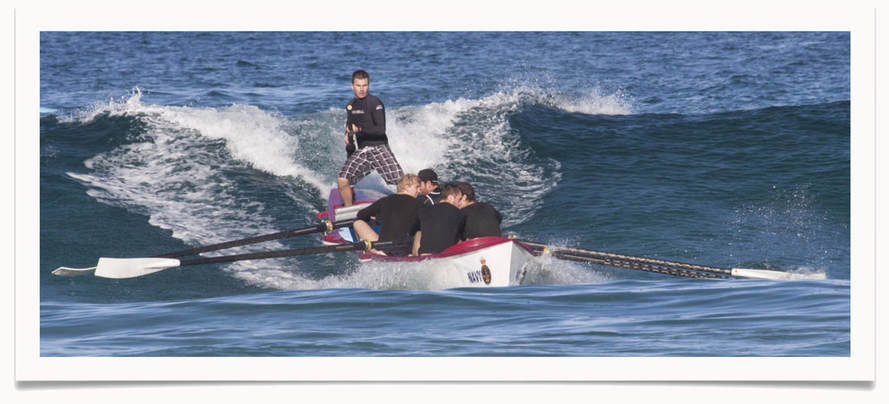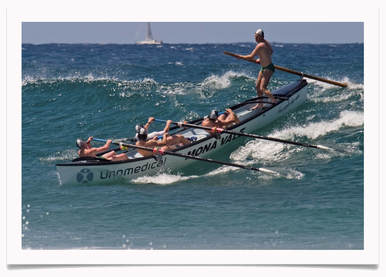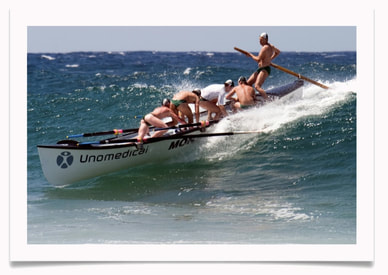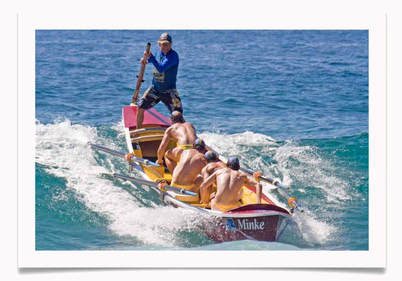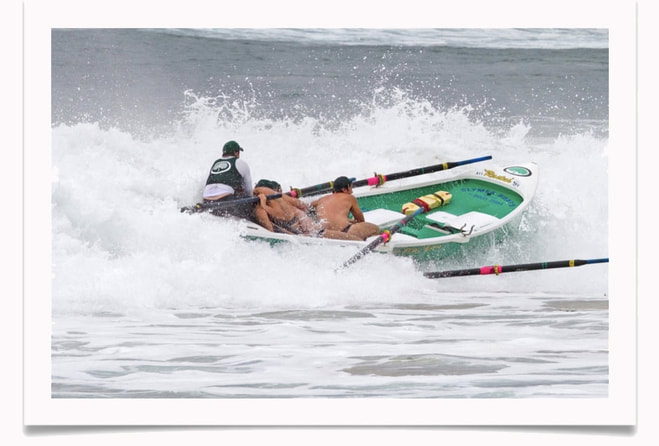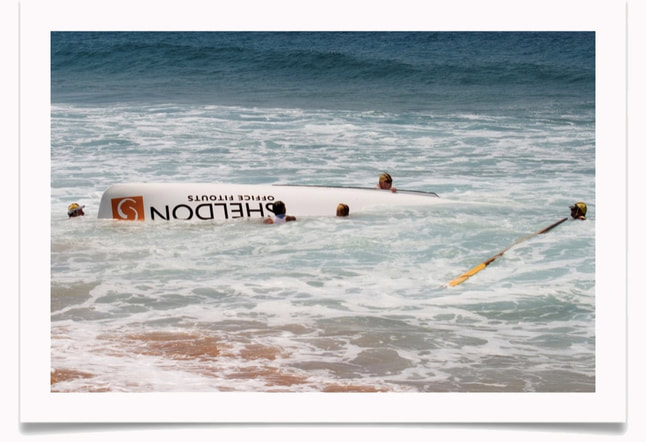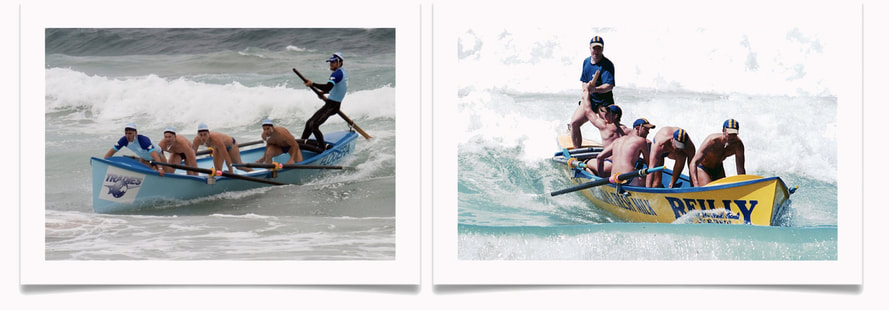SURF SKILLS
HANDLING SURFBOATS IN SURF CONDITIONS
SAFETY & SURF SKILLS
Surfboat coaches must focus on the surf aspects of our sport.
Currently assessing competitor safety is in danger of being based on bureaucratic procedures rather than on the ability of a crew and its level of surf skills.
The most significant surfboat safety initiative would be a sport wide program to improve the surf skills of surfboat competitors.
The sweep is responsible to manage the crew and craft in the surf (especially in the wave zone). But the rowers share some responsibility. They should have adequate skills to help control the boat. Currently Sweeps need to be accredited but there is no system acknowledging the capability of rowers or the crew as a whole. This results in decisions at events being based on crews with the least capability.
The best crews and Sweeps today are probably just as competent as the best in past eras. But nowadays the ability of the average crew is substantially lower than average crews of the past. Generally there is now less emphasis on surf skill development. The training time spent in surf is diminishing.
ASSESSING SURF CONDITIONS
Safety awareness must be practised during surf skill training. Rescue services may not be as available as they are during competition.
An observation based safety assessment should be done before entering the surf. Assess the type of wave; number of waves between sets; currents; effect of the wind; depth of water; rocks; and the location of swimmers and board riders.
The main consideration of a safety assessment is the ability and confidence of the sweep and rowers to match the conditions.
SURFBOAT SURF SKILLS TRAINING
Identify the skills to work on then plan specific surf skills training activities.
Do not simply repeat a surf skill over and over again. Analyse what is needed to foster the skill – then apply it in a way it can become second nature. Most surf skills need to become instinctive.
Familiarisation is a key element in surf skills training.
It is obvious which crews do extensive surf skills training by the advantage they obtain when conditions deteriorate. Talented surfboat rowers have an attitude that they can ‘surf with their oars’.
FITNESS TRAINING FOR SURF SKILLS
Analyse what the body does in performing specific surf skills and target exercise routines that physically enhance these aspects of the body. Many surf skills require various types of strength, while others require flexibility and balance.
Mentally we need to prepare ourselves to accept and react to the unexpected. Investigate ways to improve balance, reflexes and flexibility.
Surfboat coaches must focus on the surf aspects of our sport.
Currently assessing competitor safety is in danger of being based on bureaucratic procedures rather than on the ability of a crew and its level of surf skills.
The most significant surfboat safety initiative would be a sport wide program to improve the surf skills of surfboat competitors.
The sweep is responsible to manage the crew and craft in the surf (especially in the wave zone). But the rowers share some responsibility. They should have adequate skills to help control the boat. Currently Sweeps need to be accredited but there is no system acknowledging the capability of rowers or the crew as a whole. This results in decisions at events being based on crews with the least capability.
The best crews and Sweeps today are probably just as competent as the best in past eras. But nowadays the ability of the average crew is substantially lower than average crews of the past. Generally there is now less emphasis on surf skill development. The training time spent in surf is diminishing.
ASSESSING SURF CONDITIONS
Safety awareness must be practised during surf skill training. Rescue services may not be as available as they are during competition.
An observation based safety assessment should be done before entering the surf. Assess the type of wave; number of waves between sets; currents; effect of the wind; depth of water; rocks; and the location of swimmers and board riders.
The main consideration of a safety assessment is the ability and confidence of the sweep and rowers to match the conditions.
SURFBOAT SURF SKILLS TRAINING
Identify the skills to work on then plan specific surf skills training activities.
Do not simply repeat a surf skill over and over again. Analyse what is needed to foster the skill – then apply it in a way it can become second nature. Most surf skills need to become instinctive.
Familiarisation is a key element in surf skills training.
It is obvious which crews do extensive surf skills training by the advantage they obtain when conditions deteriorate. Talented surfboat rowers have an attitude that they can ‘surf with their oars’.
FITNESS TRAINING FOR SURF SKILLS
Analyse what the body does in performing specific surf skills and target exercise routines that physically enhance these aspects of the body. Many surf skills require various types of strength, while others require flexibility and balance.
Mentally we need to prepare ourselves to accept and react to the unexpected. Investigate ways to improve balance, reflexes and flexibility.
SPECIFIC SURF SKILLS ACTIVITIES
STARTING
The Start is a major strategic skill warranting specialised coaching. become a speciality.
There are many methods to enter a surfboat at the start of a race. The same principle applies to all techniques - quickly accelerate the stationary boat to a stage where rhythmic rowing can commence – preferably ahead of the competition.
Strokes taken at the start of a race need to be strong, energetic and bright especially in shallow water. They are starting strokes not rowing strokes. Mental attitude needs to be tough and determined.
The purpose of each stroke is to accelerate the hull until it is at full speed. The blade must be in the water to generate power, therefore starting strokes should not be too short.
The number of starting strokes will depend on the depth of water and the reduction of speed from hitting waves.
Starting strokes may appear to become easier as the boat accelerates. Do not accept this! Good starting crews counteract this by increasing the power they apply. One needs to address each starting stroke as – “hard, harder, harder” until the depth of water releases the hull. Once the hull is released the rowers can go through the transition from starting strokes to more rhythmic rowing strokes.
The Start is a major strategic skill warranting specialised coaching. become a speciality.
There are many methods to enter a surfboat at the start of a race. The same principle applies to all techniques - quickly accelerate the stationary boat to a stage where rhythmic rowing can commence – preferably ahead of the competition.
Strokes taken at the start of a race need to be strong, energetic and bright especially in shallow water. They are starting strokes not rowing strokes. Mental attitude needs to be tough and determined.
The purpose of each stroke is to accelerate the hull until it is at full speed. The blade must be in the water to generate power, therefore starting strokes should not be too short.
The number of starting strokes will depend on the depth of water and the reduction of speed from hitting waves.
Starting strokes may appear to become easier as the boat accelerates. Do not accept this! Good starting crews counteract this by increasing the power they apply. One needs to address each starting stroke as – “hard, harder, harder” until the depth of water releases the hull. Once the hull is released the rowers can go through the transition from starting strokes to more rhythmic rowing strokes.
ROWING IN SHALLOW WATER
The hull will feel as if it is being held back when rowing in shallow water. Ensure strokes are long enough to build momentum, as with ‘starting strokes’. It is important not to overpower the oar. Do not bring the body up to meet the oar handle – take the handle to the body. Combine body leverage with leg drive.
ROWING SEAWARD IN A RIP
If the boat receives the benefit of outflowing water the hands need to be bright (quick) at the catch. This avoids the stroke being shortened by the increased speed of the boat taking the blade past the usual entry point.
WAITING IN THE SURF BREAK
If the boat needs to stop in the surf zone to avoid incoming waves, ensure the current does not suck the boat towards the breaking waves. Practise stopping and holding the boat in a set position. This may involve ‘checking’ the boat by rowing backwards.
ROWING IN A CROSS CURRENT
Avoid clashing oars with neighbouring boats when rowing through a cross current. Angle the boat at the start towards the current to counter its effect on the hull during the first few strokes.
ROWING THROUGH WAVES
The four blades should be particularly synchronised in their timing and application of power when rowing through the wave zone or in choppy, windy conditions. It is important the four rowers need to do the same thing at the same time!
Rowing through or over waves the Stroke should visualise the Bowperson’s blade and adjust timing to assist the Bow to take clean strokes.
If a wave slows the boat’s momentum apply forceful starting strokes to get it moving again.
Going over a large wave the bow may shoot high out of the water ‘getting air’. This presents an opportunity to gain an advantage. A stroke should be rowed while the hull is in the air. Two things are achieved by rowing while the hull is airborne. Firstly, power can be applied with little hull resistance. Secondly, the loss of momentum caused by the boat kniving into the water is minimised.
When the bow is high in the air, rowers (particularly the bow pair) may need to raise their backside’s high off the seats to help them raise their oar handle in order for their blade to reach the water. The feet should cushion the backside to avoid landing heavily on the seat. Take care to land in the middle of the seat as many Bow rowers have suffered a damaged coccyx (tailbone) by landing on their seat’s raised edge.
BACKSHOOT RECOVERY
A backshoot occurs when the force of a wave stops the boats forward motion and causes it to move backwards with the wave.
A forceful uncontrollable backshoot may result in a rollover, or leave the boat side on to incoming waves. Calmly recover. Skilled crews can minimise the impact of a backshoot.
Often backshoots can be controlled by the rowers taking the weight on their blades (digging) to stop the backward movement of the hull. The pressure exerted by the blades on either side of the boat should be balanced.
Progress to sea should be recommenced as soon as possible as there may be bigger waves coming!
Sweeps and crews with good surf skills backshoot less than the majority that simply charge into waves trusting their high volume pumps will overcome poor judgement.
The hull will feel as if it is being held back when rowing in shallow water. Ensure strokes are long enough to build momentum, as with ‘starting strokes’. It is important not to overpower the oar. Do not bring the body up to meet the oar handle – take the handle to the body. Combine body leverage with leg drive.
ROWING SEAWARD IN A RIP
If the boat receives the benefit of outflowing water the hands need to be bright (quick) at the catch. This avoids the stroke being shortened by the increased speed of the boat taking the blade past the usual entry point.
WAITING IN THE SURF BREAK
If the boat needs to stop in the surf zone to avoid incoming waves, ensure the current does not suck the boat towards the breaking waves. Practise stopping and holding the boat in a set position. This may involve ‘checking’ the boat by rowing backwards.
ROWING IN A CROSS CURRENT
Avoid clashing oars with neighbouring boats when rowing through a cross current. Angle the boat at the start towards the current to counter its effect on the hull during the first few strokes.
ROWING THROUGH WAVES
The four blades should be particularly synchronised in their timing and application of power when rowing through the wave zone or in choppy, windy conditions. It is important the four rowers need to do the same thing at the same time!
Rowing through or over waves the Stroke should visualise the Bowperson’s blade and adjust timing to assist the Bow to take clean strokes.
If a wave slows the boat’s momentum apply forceful starting strokes to get it moving again.
Going over a large wave the bow may shoot high out of the water ‘getting air’. This presents an opportunity to gain an advantage. A stroke should be rowed while the hull is in the air. Two things are achieved by rowing while the hull is airborne. Firstly, power can be applied with little hull resistance. Secondly, the loss of momentum caused by the boat kniving into the water is minimised.
When the bow is high in the air, rowers (particularly the bow pair) may need to raise their backside’s high off the seats to help them raise their oar handle in order for their blade to reach the water. The feet should cushion the backside to avoid landing heavily on the seat. Take care to land in the middle of the seat as many Bow rowers have suffered a damaged coccyx (tailbone) by landing on their seat’s raised edge.
BACKSHOOT RECOVERY
A backshoot occurs when the force of a wave stops the boats forward motion and causes it to move backwards with the wave.
A forceful uncontrollable backshoot may result in a rollover, or leave the boat side on to incoming waves. Calmly recover. Skilled crews can minimise the impact of a backshoot.
Often backshoots can be controlled by the rowers taking the weight on their blades (digging) to stop the backward movement of the hull. The pressure exerted by the blades on either side of the boat should be balanced.
Progress to sea should be recommenced as soon as possible as there may be bigger waves coming!
Sweeps and crews with good surf skills backshoot less than the majority that simply charge into waves trusting their high volume pumps will overcome poor judgement.
ROWING IN CHOPPY WATER
The hull may be constantly checked (slowed) in chop, discouraging it effectively running between strokes. Maintain length through the stroke. During practise in choppy conditions feel the effect different stroke styles have on the run of the hull.
ROWING IN A CROSS WIND
Strong side winds tend to blow most modern surfboats into the wind by having a greater influence on the tuck than the bow. Even experienced Sweeps can be challenged by strong cross winds. Light carbon fibre oars can also be affected as the wind catches the blade.
Become familiar with the feel of the boat and oars by practising in the wind.
BUOY TURNS
There are several techniques used to turn the buoys. Experiment to determine the best method for your crew.
Today surfboats have the ability to “spin’ to change direction rather than gradually ‘turn’ because the keel is now deeper and shorter. The Stroke’s blade has now become a significant turning tool.
It is advantageous to maintain forward motion during the turn to avoid the need to restart a stopped boat.
ROWING OUT OF A BUOY TURN
Optimising a buoy turn depends on how fast the crew can row away from the cans. The ideal turning course is a tight spin that avoids a meandering wide arc. Video buoy turns to analyse the boat’s performance during the turn and rowing out of the turn.
RUNNING SWELLS
The skill to maximise the run gained on a swell has a huge competitive advantage.
The key to running a swell is to build the speed of the boat as the swell approaches and then to keep the bow down when on the swell to maximise the run. Bright (fast) hands are required when the boat is running swells to maintain resistance on the water .
Avoid decreasing effort as the boat comes off the back of a swell. Allowing the boat to slow too much coming off a run minimises the ability to pick up the next swell.
Once on a run the bow can be kept down by holding the bodies back a little longer at the finish. Holding the bodies back at the finish helps maximise the run gained on a swell.
Running swells should be constantly practised. It challenges your breathing and improves fitness. Expire air fully in order to inhale deeply.
ROWING ONTO A WAVE
The boat usually accelerates when rowing on to a wave. Blades need to be placed in the water more quickly to maintain power.
Boat speed is the key to catching waves. Ensure rowers maintain powerful rowing until the Sweep gives a command such as ‘easy oar’ or ‘come aft’. Do not allow rowers to slacken off when the resistance on the blade diminishes.
When training to catch waves do not always take off from the ideal spot at the ideal time.
ON A WAVE – SITTING ON SEATS HOLDING OARS
Sitting on the seat with your oar in your hands while on a wave is a skill. It is essential to concentrate on the blade. Catching a crab on a wave is dangerous as the oar may throw the rower out of the boat.
Concentrate on the blade when easy oar on a wave.
ON A WAVE SITTING ON SEASTS TRAILING OARS
Trailing oars while staying in your seats on a wave is not common these days. It used to be done on very big waves after the boat was committed while it was too early to transfer the weight towards the back (tuck).
The hull may be constantly checked (slowed) in chop, discouraging it effectively running between strokes. Maintain length through the stroke. During practise in choppy conditions feel the effect different stroke styles have on the run of the hull.
ROWING IN A CROSS WIND
Strong side winds tend to blow most modern surfboats into the wind by having a greater influence on the tuck than the bow. Even experienced Sweeps can be challenged by strong cross winds. Light carbon fibre oars can also be affected as the wind catches the blade.
Become familiar with the feel of the boat and oars by practising in the wind.
BUOY TURNS
There are several techniques used to turn the buoys. Experiment to determine the best method for your crew.
Today surfboats have the ability to “spin’ to change direction rather than gradually ‘turn’ because the keel is now deeper and shorter. The Stroke’s blade has now become a significant turning tool.
It is advantageous to maintain forward motion during the turn to avoid the need to restart a stopped boat.
ROWING OUT OF A BUOY TURN
Optimising a buoy turn depends on how fast the crew can row away from the cans. The ideal turning course is a tight spin that avoids a meandering wide arc. Video buoy turns to analyse the boat’s performance during the turn and rowing out of the turn.
RUNNING SWELLS
The skill to maximise the run gained on a swell has a huge competitive advantage.
The key to running a swell is to build the speed of the boat as the swell approaches and then to keep the bow down when on the swell to maximise the run. Bright (fast) hands are required when the boat is running swells to maintain resistance on the water .
Avoid decreasing effort as the boat comes off the back of a swell. Allowing the boat to slow too much coming off a run minimises the ability to pick up the next swell.
Once on a run the bow can be kept down by holding the bodies back a little longer at the finish. Holding the bodies back at the finish helps maximise the run gained on a swell.
Running swells should be constantly practised. It challenges your breathing and improves fitness. Expire air fully in order to inhale deeply.
ROWING ONTO A WAVE
The boat usually accelerates when rowing on to a wave. Blades need to be placed in the water more quickly to maintain power.
Boat speed is the key to catching waves. Ensure rowers maintain powerful rowing until the Sweep gives a command such as ‘easy oar’ or ‘come aft’. Do not allow rowers to slacken off when the resistance on the blade diminishes.
When training to catch waves do not always take off from the ideal spot at the ideal time.
ON A WAVE – SITTING ON SEATS HOLDING OARS
Sitting on the seat with your oar in your hands while on a wave is a skill. It is essential to concentrate on the blade. Catching a crab on a wave is dangerous as the oar may throw the rower out of the boat.
Concentrate on the blade when easy oar on a wave.
ON A WAVE SITTING ON SEASTS TRAILING OARS
Trailing oars while staying in your seats on a wave is not common these days. It used to be done on very big waves after the boat was committed while it was too early to transfer the weight towards the back (tuck).
ON A WAVE – GOING AFT
Cleanly going aft while keeping the boat balanced is an important surf skill that greatly assists the Sweep to keep the boat straight.
When the boat is moving under the power of the wave the Sweep gives the command to come aft. The rowers complete their stroke and move up the centre of the boat, keeping the gunwales level.
Waves that break in a quick action, such as hollow dumping (plunging) waves, will force the sweep oar handle downwards. The Sweep may train a rower to assist holding the handle up for a short time to prevent the sweep oar handle being forced downwards, losing contact with the wave.
Cleanly going aft while keeping the boat balanced is an important surf skill that greatly assists the Sweep to keep the boat straight.
When the boat is moving under the power of the wave the Sweep gives the command to come aft. The rowers complete their stroke and move up the centre of the boat, keeping the gunwales level.
Waves that break in a quick action, such as hollow dumping (plunging) waves, will force the sweep oar handle downwards. The Sweep may train a rower to assist holding the handle up for a short time to prevent the sweep oar handle being forced downwards, losing contact with the wave.
BROACHING ON A WAVE
Broaching occurs when a boat goes sideways on a wave and continues across the face. Preventing a rollover during a broach is a skill.
The Sweep and rowers need to take action that will improve their chances of overcoming a broach. The Sweep should cease fighting the oar and try to stay in the boat to regain control later.
When the boat is going sideways the rowers should place their weight on the side facing the wave and balance the boat to prevent it rolling over. The facing the wave is known as the ‘high side’.
When the energy of the wave is sufficiently reduced the Sweep can regather the sweep oar and turn the boat shorewards.
Broaching occurs when a boat goes sideways on a wave and continues across the face. Preventing a rollover during a broach is a skill.
The Sweep and rowers need to take action that will improve their chances of overcoming a broach. The Sweep should cease fighting the oar and try to stay in the boat to regain control later.
When the boat is going sideways the rowers should place their weight on the side facing the wave and balance the boat to prevent it rolling over. The facing the wave is known as the ‘high side’.
When the energy of the wave is sufficiently reduced the Sweep can regather the sweep oar and turn the boat shorewards.
CAPSIZING
Capsizing is not a skill, but the crew’s ability to calmly recover and continue is definitely a skill!
The most critical safety issue in surfboats is to check the number of heads after a boat capsizes.
Following a capsize immediately check all crew are present and okay. Avoid being on the shoreward side of the boat. Then right the boat pointing it into incoming waves, regather the oars, engage the pumps and recommence racing. Easy!
Capsizing is not a skill, but the crew’s ability to calmly recover and continue is definitely a skill!
The most critical safety issue in surfboats is to check the number of heads after a boat capsizes.
Following a capsize immediately check all crew are present and okay. Avoid being on the shoreward side of the boat. Then right the boat pointing it into incoming waves, regather the oars, engage the pumps and recommence racing. Easy!
GOING FORWARD
After going aft on a wave one or more of the crew may need to go forward to encourage the boat to continue running on the wave. This distributes more weight into the bow.
After going aft on a wave one or more of the crew may need to go forward to encourage the boat to continue running on the wave. This distributes more weight into the bow.
REGATHERING TRAILED OARS
After trailing oars on a wave rowers may need to resume their seats and to recommence rowing to ensure the boat continues to run on the wave.
Regathering oars is a useful skill that should be practised. Consider the best way for the trailed oars to be reclaimed and the best way to resume rowing.
Regathering an oar may be assisted by rowers on one side pushing the trailing shaft outwards for the rowers behind them. The Stroke does not receive such a benefit, but their oar is the easiest to retrieve!
If a trailed blade is facing downwards, roll the shaft to curve the blade upwards before pushing it out for your mate to regather.
RECOMMENCING TO ROW
Place the blade in the water very quickly at the catch when the boat is moving rapidly on a wave to avoid a forceful ‘crab’.
ROWING TO THE BEACH OVER A SANDBANK
The momentum of the boat will slow in shallow water due to increased hull resistance.
Train for this scenario when the crew is tired. They will experience it in a race when they are depleted. Many races are won in the last few strokes.
VARYING ROWING STYLE
Some experienced crews gain an advantage by their ability to adjust their rowing style for various conditions or stages of a surfboat race. While other crews may only adjust their ‘stroke rate’.
EXTREME CONDITIONS
Preparation for extreme conditions, including challenging waves and extreme wind is important. Assess safety factors and the ability of the crew as well as the sweep. It is valid to prepare crews to cope with extreme conditions due to possible sudden changes they may experience at sea. The race strategy for extreme conditions is to simply make it out and back!
After trailing oars on a wave rowers may need to resume their seats and to recommence rowing to ensure the boat continues to run on the wave.
Regathering oars is a useful skill that should be practised. Consider the best way for the trailed oars to be reclaimed and the best way to resume rowing.
Regathering an oar may be assisted by rowers on one side pushing the trailing shaft outwards for the rowers behind them. The Stroke does not receive such a benefit, but their oar is the easiest to retrieve!
If a trailed blade is facing downwards, roll the shaft to curve the blade upwards before pushing it out for your mate to regather.
RECOMMENCING TO ROW
Place the blade in the water very quickly at the catch when the boat is moving rapidly on a wave to avoid a forceful ‘crab’.
ROWING TO THE BEACH OVER A SANDBANK
The momentum of the boat will slow in shallow water due to increased hull resistance.
Train for this scenario when the crew is tired. They will experience it in a race when they are depleted. Many races are won in the last few strokes.
VARYING ROWING STYLE
Some experienced crews gain an advantage by their ability to adjust their rowing style for various conditions or stages of a surfboat race. While other crews may only adjust their ‘stroke rate’.
EXTREME CONDITIONS
Preparation for extreme conditions, including challenging waves and extreme wind is important. Assess safety factors and the ability of the crew as well as the sweep. It is valid to prepare crews to cope with extreme conditions due to possible sudden changes they may experience at sea. The race strategy for extreme conditions is to simply make it out and back!
